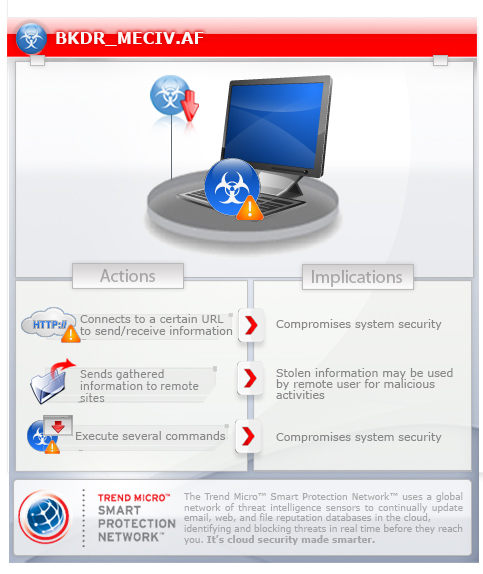BKDR_MECIV.AF
TrojanDropper:Win32/Datcaen.A (Microsoft), Trojan.Win32.Zapchast.aejv (Kaspersky), Trojan.Gen.2 (Symantec), Generic Dropper!1yb (NAI), Gen:Trojan.Heur.hqW@IXhqgihi (FSecure), Trojan-Dropper.Win32.XoredBinary.b (v) (Sunbelt), TR/Spy.114688.531 (Antivir), W32/Dropper.6!Generic (Authentium), Gen:Trojan.Heur.hqW@IXhqgihi (Bitdefender), W32/Pucedoor.A (Fortinet), W32/Dropper.6!Generic (Fprot), Trojan.Win32.Spy (Ikarus), probably a variant of Win32/Pucedoor.A trojan (NOD32), Generic (Panda), Backdoor.Wmdm (VBA32)
Windows 2000, Windows XP, Windows Server 2003


Threat Type: Backdoor
Destructiveness: No
Encrypted: Yes
In the wild: Yes
OVERVIEW
Both malware are related to the modified Enfal variants, which were reported to have infected 874 systems in 33 countries.
To get a one-glance comprehensive view of the behavior of this Backdoor, refer to the Threat Diagram shown below.

This backdoor arrives on a system as a file dropped by other malware or as a file downloaded unknowingly by users when visiting malicious sites. It may be dropped by other malware.
It connects to a website to send and receive information.
It deletes itself after execution.
TECHNICAL DETAILS
Arrival Details
This backdoor arrives on a system as a file dropped by other malware or as a file downloaded unknowingly by users when visiting malicious sites.
It may be dropped by the following malware:
- TROJ_ARTIEF.JN
Installation
This backdoor drops the following component file(s):
- %System%\datac1en.dll - detected as BKDR_MECIV.AF
(Note: %System% is the Windows system folder, which is usually C:\Windows\System on Windows 98 and ME, C:\WINNT\System32 on Windows NT and 2000, or C:\Windows\System32 on Windows XP and Server 2003.)
Its DLL component is injected to the following process(es):
- svchost.exe
Autostart Technique
This backdoor registers itself as a system service to ensure its automatic execution at every system startup by adding the following registry entries:
HKEY_LOCAL_MACHINE\SYSTEM\CurrentControlSet\
Services\WmdmPmSp
ImagePath = "%SystemRoot%\System32\svchost.exe -k netsvcs"
Other System Modifications
This backdoor adds the following registry entries as part of its installation routine:
HKEY_LOCAL_MACHINE\SYSTEM\CurrentControlSet\
Services\WmdmPmSp\Parameters
ServiceDll = "%SystemRoot%\System32\datac1en.dll"
HKEY_LOCAL_MACHINE\SYSTEM\CurrentControlSet\
Services\WmdmPmSp\Security
Security = "{Random Numbers}"
Backdoor Routine
This backdoor connects to the following websites to send and receive information:
- http://home.{BLOCKED}ibus.com
It posts the following information to its command and control (C&C) server:
- Hostname
- MAC address
- IP address
- Operating System
- File name of the malicious executable
- Campaign name
Other Details
This backdoor does the following:
- Downloads and execute other malware
- List files from a specific directory
- Terminate processes
- Update its C&C servers
It deletes itself after execution.
NOTES:
It sends the information to its C&C server using the following format:
- http://home.{BLOCKED}ibus.com/%7b{Campaign name 1}/{Campaign name 2}/{HostName:MAC Address}/{Campaign name 3}
SOLUTION
Step 1
For Windows XP and Windows Server 2003 users, before doing any scans, please make sure you disable System Restore to allow full scanning of your computer.
Step 3
Restart in Safe Mode, and then delete this registry key
Important: Editing the Windows Registry incorrectly can lead to irreversible system malfunction. Please do this step only if you know how or you can ask assistance from your system administrator. Else, check this Microsoft article first before modifying your computer's registry.
- In HKEY_LOCAL_MACHINE\SYSTEM\CurrentControlSet\Services\WmdmPmSp
- ImagePath = "%SystemRoot%\System32\svchost.exe -k netsvcs"
- ImagePath = "%SystemRoot%\System32\svchost.exe -k netsvcs"
Step 4
Restart in normal mode and scan your computer with your Trend Micro product for files detected as BKDR_MECIV.AF. If the detected files have already been cleaned, deleted, or quarantined by your Trend Micro product, no further step is required. You may opt to simply delete the quarantined files. Please check this Knowledge Base page for more information.
Did this description help? Tell us how we did.

